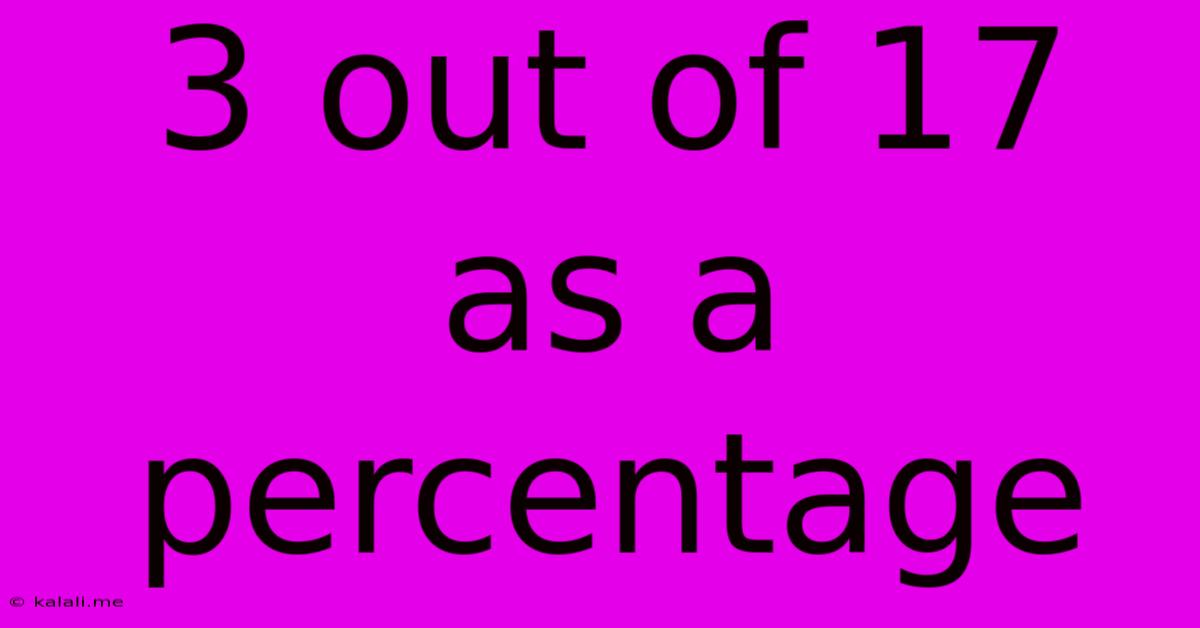3 Out Of 17 As A Percentage
Kalali
May 10, 2025 · 2 min read

Table of Contents
3 Out of 17 as a Percentage: A Simple Calculation and its Applications
Calculating percentages is a fundamental skill with applications across various fields, from everyday finances to complex statistical analysis. This article will guide you through calculating "3 out of 17 as a percentage," explaining the process and highlighting its practical uses. Understanding this simple calculation can significantly improve your comprehension of data representation and problem-solving.
Understanding the Basics of Percentages
A percentage represents a fraction of 100. The symbol "%" signifies "per hundred." For example, 50% means 50 out of 100, or 50/100, which simplifies to 1/2. Converting fractions to percentages involves finding the equivalent fraction with a denominator of 100.
Calculating 3 Out of 17 as a Percentage
To calculate 3 out of 17 as a percentage, follow these steps:
-
Express as a fraction: Write the given information as a fraction: 3/17.
-
Convert to decimal: Divide the numerator (3) by the denominator (17): 3 ÷ 17 ≈ 0.1765
-
Convert to percentage: Multiply the decimal by 100: 0.1765 x 100 = 17.65%
Therefore, 3 out of 17 is approximately 17.65%.
Rounding Percentages
In many situations, you'll need to round your percentage to a certain number of decimal places. For example, you might round 17.65% to 18% for simpler communication or to maintain consistency across a dataset. The level of rounding depends on the context and required precision.
Practical Applications
Understanding how to calculate percentages like "3 out of 17" has various practical applications:
-
Academic Performance: Imagine you answered 3 questions correctly out of 17 on a quiz. This calculation helps determine your percentage score (17.65%).
-
Sales and Marketing: If 3 out of 17 marketing campaigns were successful, this percentage helps evaluate campaign effectiveness.
-
Data Analysis: In larger datasets, calculating percentages allows you to summarize and interpret the proportion of certain values within the data.
-
Financial Calculations: Understanding percentages is crucial for calculating interest, discounts, taxes, and other financial computations.
-
Probability and Statistics: Percentages are frequently used to express probabilities and likelihoods in various statistical applications.
Beyond the Basics: Working with Larger Numbers
The same principles apply when dealing with larger numbers. For example, if you wanted to calculate the percentage of successful outcomes from a sample of 1700 with 300 successful events you would follow the same process using the fraction 300/1700 which would also come out at approximately 17.65%.
Conclusion
Calculating percentages is a simple yet powerful tool. Understanding how to determine "3 out of 17 as a percentage" and applying this knowledge to various real-world scenarios can improve your analytical and problem-solving abilities. Remember the key steps: convert to a fraction, then a decimal, and finally, multiply by 100 to express it as a percentage. Mastering this skill will improve your data interpretation abilities significantly.
Latest Posts
Latest Posts
-
What Are 2004 Pennies Worth Worlds Easyest Game
Jul 04, 2025
-
Who Did Alan Jackson Have An Affair With
Jul 04, 2025
-
How Much Is 500 Grams Of Ground Beef
Jul 04, 2025
-
1 Pound Pasta Is How Many Cups
Jul 04, 2025
-
How Many Cans Of Soda Are In A 2 Liter
Jul 04, 2025
Related Post
Thank you for visiting our website which covers about 3 Out Of 17 As A Percentage . We hope the information provided has been useful to you. Feel free to contact us if you have any questions or need further assistance. See you next time and don't miss to bookmark.